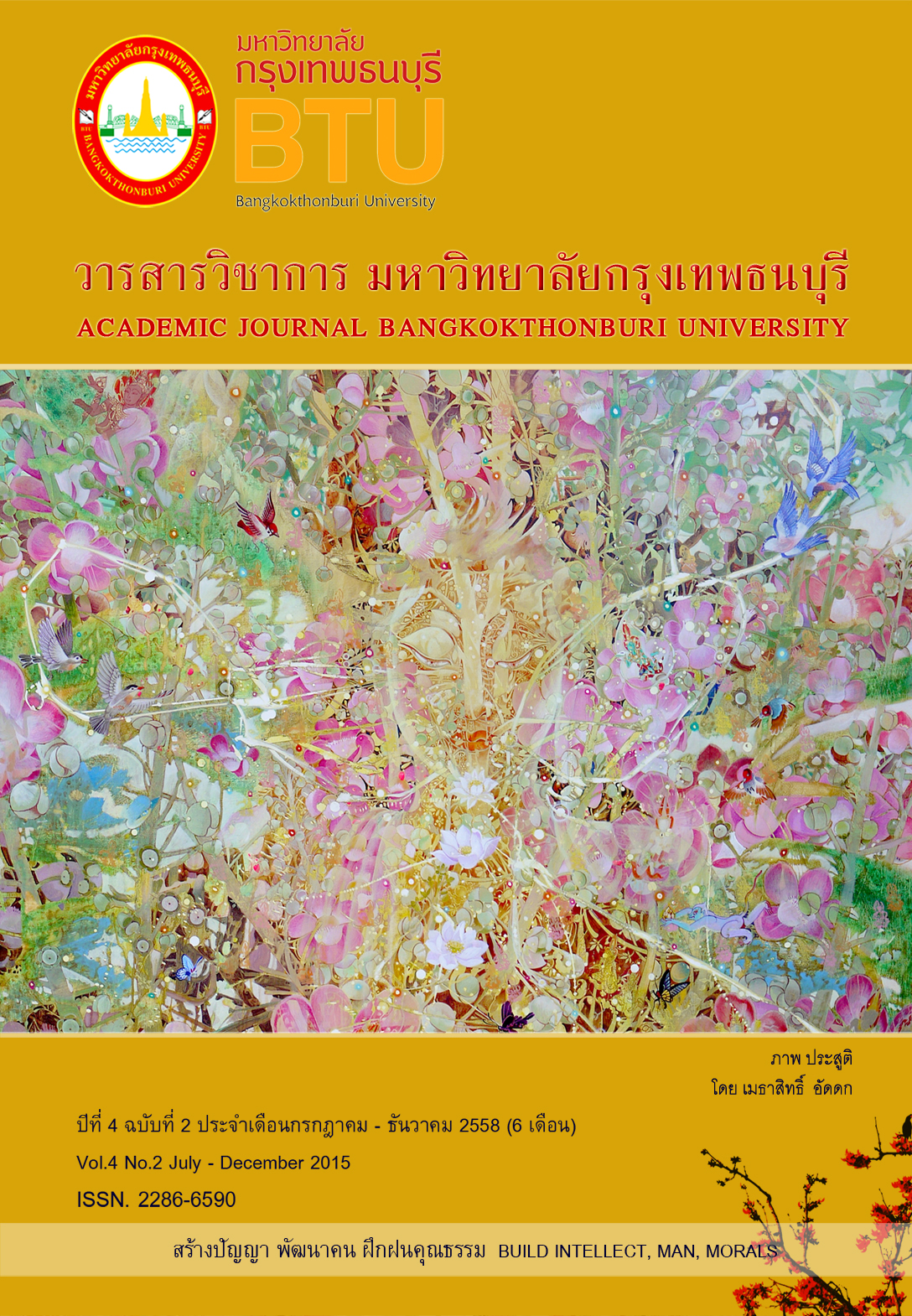ยุทธศาสตร์การเผยแผ่พระพุทธศาสนาเพื่อความมั่นคงแห่งชาติอย่างยั่งยืน
Main Article Content
Abstract
บทคัดย่อ
การศึกษาวิจัยนี้ มีวัตถุประสงค์เพื่อ 1) เพื่อศึกษายุทธศาสตร์การเผยแผ่พระพุทธศาสนาเพื่อความมั่นคงแห่งชาติอย่างยั่งยืน 2)เพื่อศึกษาปัจจัยที่มีผลต่อการกำหนดยุทธศาสตร์การเผยแผ่พระพุทธศาสนาเพื่อความมั่นคงแห่งชาติอย่างยั่งยืน 3)เพื่อเสนอยุทธศาสตร์การเผยแผ่พระพุทธศาสนาเพื่อความมั่นคงแห่งชาติอย่างยั่งยืน การวิจัยนี้เป็นการวิจัยแบบผสานวิธีคือการวิจัยเชิงปริมาณและการวิจัยเชิงคุณภาพ การวิจัยเชิงปริมาณศึกษากลุ่มตัวอย่างจำนวน 365 รูป/คน ซึ่งได้มาจากวิธีการสุ่มตัวอย่างแบบแบ่งชั้น จากจำนวนประชากรทั้งหมด 4,109 รูป/คน และการสุ่มตัวอย่างแบบง่าย และกำหนดเป็นสัดส่วนตามจำนวนประชากรในแต่ละชั้น คำนวณขนาดกลุ่มตัวอย่างโดยใช้สูตรของทาโร่ ยามาเน่ สถิติที่ใช้ในการวิเคราะห์ข้อมูลประกอบด้วยสถิติเชิงพรรณนา ได้แก่ ค่าร้อยละ ค่าเฉลี่ย ส่วนเบี่ยงเบนมาตรฐาน การวิเคราะห์การถดถอยแบบขั้นตอนและการวิจัยเชิงคุณภาพ ดำเนินการโดยการสัมภาษณ์เชิงลึกผู้ให้ข้อมูลสำคัญ จำนวน 30 รูป/คน ที่เป็นพระสังฆาธิการและผู้บริหารเจ้าหน้าที่สำนักงานพระพุทธศาสนาจังหวัด ได้มาโดยการเลือกแบบเจาะจง วิเคราะห์ข้อมูลโดยการวิเคราะห์เชิงเนื้อหา
ผลการศึกษา พบว่า
1. ยุทธศาสตร์การเผยแผ่พระพุทธศาสนาเพื่อความมั่นคงแห่งชาติอย่างยั่งยืนมีผลการเผยแผ่โดยรวม อยู่ในระดับมาก (X = 4.05, S.D. = .780) เมื่อพิจารณาเป็นรายด้าน พบว่า ด้านการสืบทอดอายุพระพุทธศาสนาให้ดำรงอยู่คู่สังคมไทยอย่างยั่งยืนของคณะสงฆ์มีผลการเผยแผ่อยู่ในระดับสูงสุด (X = 4.06, S.D. = .843) รองลงมาคือด้านการเสริมสร้างความศรัทธาในพระพุทธศาสนาที่ยั่งยืนแก่พุทธศาสนิกชน มีผลการเผยแผ่ (X = 4.06, S.D. = .846) และด้านการนำเสนอและรักษาหลักธรรมที่เป็นแก่นแท้ทางพระพุทธศาสนา มีผลการเผยแผ่ (X = 4.04,S.D. = .807) ตามลำดับ
2. ปัจจัยที่มีผลต่อการกำหนดยุทธศาสตร์การเผยแผ่พระพุทธศาสนาเพื่อความมั่นคงแห่งชาติอย่างยั่งยืนมี 2 ปัจจัย คือ 1) ปัจจัยด้านหลักธรรมในการเผยแผ่พระพุทธศาสนา มี 3 ตัวแปร ได้แก่ (1) อริยสัจ4 (2) สังคหะวัตถุ4และ (3) ปัจฉิมโอวาท และ2) ปัจจัยด้านวิธีการเผยแผ่พระพุทธศาสนา มี 3 ตัวแปร ได้แก่ (1) วิธีการสาธยาย บรรยาย สนทนา ปาฐกถา (2) วิธีการเผยแผ่ทางทีวีพระพุทธศาสนา และ(3) วิธีการปฏิบัติสมถะและวิปัสสนากัมมัฏฐาน โดยทั้ง 2 ปัจจัยดังกล่าวสามารถอธิบายความผันแปรของยุทธศาสตร์การเผยแผ่พระพุทธศาสนาเพื่อความมั่นคงแห่งชาติอย่างยั่งยืนร้อยละ 54.50 (R-square = 0.488) อย่างมีนัยสำคัญทางสถิติที่ระดับ .05
3. ผลการวิจัยเชิงคุณภาพ ยุทธศาสตร์การเผยแผ่พระพุทธศาสนาทั้งสามด้านได้แก่ ยุทธศาสตร์การนำเสนอและรักษาหลักธรรมที่เป็นแก่นแท้ทางพระพุทธศาสนา ยุทธศาสตร์การสืบทอดอายุพระพุทธศาสนาให้ดำรงอยู่คู่สังคมไทยอย่างยั่งยืนของคณะสงฆ์ และยุทธศาสตร์การเสริมสร้างความศรัทธาในพระพุทธศาสนาที่ยั่งยืนแก่พุทธศาสนิกชน มีความสำคัญมากต่อการสร้างสังคมไทยให้ยั่งยืน ประกอบไปด้วยประเด็นดังนี้ คือ 1) พระพุทธศาสนาเป็นเสาหลักแห่งสังคม 2) พระพุทธศาสนายึดหลักธรรมาธิปไตยในการปกครองสังคม 3) พระพุทธศาสนาเป็นศูนย์รวมจิตใจของผู้คนในสังคม 4) พระพุทธศาสนาเป็นบ่อเกิดของวัฒนธรรม ประเพณี และวิถีชีวิตของผู้คนในสังคมไทย 5) พระสงฆ์เป็นผู้นำความสงบสุขมาสู่ชุมชน
6) พระสงฆ์เป็นผู้นำศีลธรรม คุณธรรม และจริยธรรมมาสู่สังคม 7) พระสงฆ์นำพาสังคมให้รู้จักสงเคราะห์เพื่อนมนุษย์ด้วยกัน และ 8) พระสงฆ์เป็นผู้ให้สติปัญญาแก่สังคม 9) พุทธบริษัทเชื่อมั่นในศักยภาพขององค์ศาสดา10) พุทธบริษัทความเชื่อมั่นในกฎแห่งกรรม 11) พุทธบริษัทเชื่อมั่นในผลของกรรม 12) พุทธบริษัทเชื่อมั่นว่ามนุษย์ต้องรับผิดชอบต่อการกระทำและผลของการกระทำนั้น
4. ยุทธศาสตร์การเผยแผ่พระพุทธศาสนาเพื่อความมั่นคงแห่งชาติอย่างยั่งยืน ที่นำเสนอประกอบด้วยการปฏิบัติที่สำคัญ 5 ประการ คือ 1) ควรกำหนดวิธีการเผยแผ่ด้วยการจัดประชุมสัมมนาเชิงปฏิบัติการ 2) ควรมีการกำหนดยุทธวิธีการเผยแผ่ที่เน้นการจัดกิจกรรมเพื่อให้ประชาชนมีส่วนร่วม 3) ควรกำหนดยุทธวิธีการสอนประชาชนให้รู้ถึงวิธีการการสร้างความสงบสุขขึ้นในจิตใจ 4) ควรปรับรูปแบบ และวิธีการที่ทันสมัยในการให้ความรู้ธรรมะทางสื่อทีวี วิทยุ 5) ควรสนับสนุนการเผยแผ่พระพุทธศาสนาทางสื่อสังคมออนไลน์ทุกรูปแบบ
Abstract
The objectives of this research were 1) to study Buddhism propagation strategies for sustainable national security 2) to study the factors influencing the formulation of the Buddhism propagation strategies for sustainable national security and 3) to propose the Buddhism propagation strategies for sustainable national security. This research was a mixed methods of research which combined both of quantitative and qualitative approaches. The quantitative research was conducted by studying the sample of 365 respondents who were selected from the population of 4,109 Sangha administrators and some executives and officers of National Office of Buddhism. They were selected by stratified sampling and simple random sampling. The sample size was obtained by the calculation of Taro Yamane formula. The research tool for data collection was a questionnaire with the reliability of and the data were analyzed by using the statistics consisted of frequency, percentage, mean, standard deviation and stepwise regression analysis. The qualitative was conducted by studying relevant documents and theories and in-dept interviewing 30 key informants who were select purposively consisted of Sangha administrators and some executives and officers of National Office of Buddhism. The data were analyzed using content analysis.
The results revealed that;
1. The Buddhism propagation strategies for sustainable national security in over all was at a highly level (X=4.05,S.D.=.780). When considered in each aspect, it found that the aspect of sustainable maintenance of Buddhism in Thai society was at the highest level (X= 4.06, S.D.=.843), followed by the aspect of sustainable encouragement of Buddhist faith to Buddhist (X=4.06,S.D.=.846) and the aspect of real presentation of Buddhist teachings (X =4.04,S.D.=.807), respectively.
2. The factors influencing the Buddhism propagation strategies for sustainable national security consisted of 2 factors, they were 1) the factor of doctrine in Buddhism propagation had 3 variables, namely Four Noble Truths, 2) Four Sangahavatthu Principles and 3) Last Obedience and 2) The factor of propagation techniques had 3 variables, namely techniques of demonstration, lecture delivery, conversation and speech making, T.V program on Buddhism and Samatha and Vipassanakammathan techniques, These two factors 2 could explain the strategic Buddhism propagation strategies for sustainable national security at 54.50 percent (R Square = 0.488) at the statistical significance level .05.
3. the qualitative research findings on the propagation of Buddhist teachings on the three spheres included the following: 1) the strategy of presentation and maintenance of Dharma principles regarded as the essence of Buddhism; 2) strategy of the succession of Buddhism so as to make Buddhism survive along with Buddhism monks forever; and 3) the strategy for the indoctrination of Buddhist beliefs. To inculcate the Buddhist teachings in Thai people is of paramount importance to the sustainability of Thai society; the essence of the matter consists of the following points: 1) Buddhism is the pillar of Thai society; 2) Buddhist strategy adheres to the principle of democracy based on Dharma principles; 3) Buddhism is the melting pot of Thai people; Buddhism gives birth to Thai culture, tradition and way of living; 5) Buddhism monks play dominant roles in bringing about peace to community; 6) Buddhist monks take the lead in providing morality and ethics to Thai society; 7) Buddhist monks help the community members learn how to assist people regardless of need and Buddhism monks help people be equipped with talent; 9) the Buddhists have a strong conviction in the potentiality of Lord Buddha; 10) Buddhists have a strong belief in the law of Karma; 11) Buddhists strongly believe in the consequence of Karma (deeds); and 12) Buddhists are convinced that all human beings must be responsible for their deeds and the consequences of those deeds.
4. Buddhism propagation strategies for sustainable national security consists of 5 important practicing, these were 1) should formulate the propagation strategy by means of holding workshops in collaboration, 2) should formulate the propagation strategic focussing on the people with participation, 3) should formulate the teaching strategic for the people to be able to create the peace of mind, 4) should remodel and modern means with view to provide the Dhamma's knowledges on T.V. and radio and 5) should support Buddhism propagation on all online social media.


